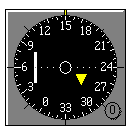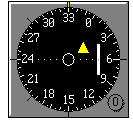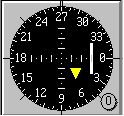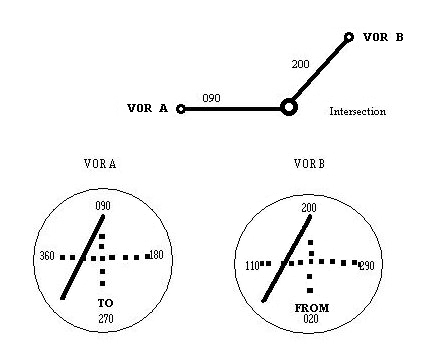The VOR
by
Joe Campbell
December, 1995
The purpose of this presentation is to explain
some interesting technical research into VOR technology and some
informal investigation of its history. I am also pleased to describe
my personal procedures for VOR navigation in the belief that others
benefit from an alternate understanding. If you wish to experiment with
the ideas and methods described here, I recommend that you use Luiz Olivera's
excellent VOR
simulator.
Pre-VOR navigation consisted of NDBs (radio
compasses) and the low-frequency "AN" system. You're
all familiar with the former, so I won't bother to explain it.
The AN system was the primary means of radio navigation familiar
to tens of thousands of pilots who returned from WWII. In the
AN system, the pilot flies between pairs of directional radio
transmitters, each modulated with a Morse code identifier. When
the aircraft is on one side of the course, a Morse 'A' is heard;
when the aircraft is on the other side of the course an 'N' is
heard. When on course, the pilot hears only a steady tone. When
directly over the station, no sound is heard ("the cone of
silence").
It's important to understand that the NDB
and the AN system have an important characteristic in common--they
are command instruments. That is, both instruments tell the pilot
unambiguously whether to turn right or left to reach the desired
course. This is an important point--this was the form of navigation
most pilots were familiar with. Their expectations and training
apparently shaped the way in which the new VOR technology was
presented to the pilot population.
As prelude to studying for my instrument
rating, I decided to learn how VOR transmitters and receivers
worked. Rooting around in the dusty off-campus engineering archives
at UC Berkeley, I located a 1949 book entitled (approximately),
"The Theory and Design of Quadrature Navigational Systems."
As its title suggests, this text explained the theory of quadrature
modulation (which I'll summarize shortly) implemented with the
vacuum-tube technology of the day--a technology I'm old enough,
alas, to understand.
While puzzling over circuit diagrams for
a VOR receiver, I noted an output labeled "Hemispherical
Station Heading Indicator." The book often refers to it merely
as the SHI. I had never heard of such a thing and was baffled
at what its purpose might be. Finally it struck me--this circuit
drives an indicator on the face of the instrument that always
indicates the headings that lead toward the VOR station.
On the earliest receivers (apparently prototypes),
were two indicator flags in the shape of arrow heads. One arrow
was located in the top half of the instrument face and points
upward. The other was located in the bottom half and points downward.
Only one of these indicators is activate at a time. Between the
two indicator arrows was written the word STATION.
Let's see how this works. Assuming no wind,
we all know that for any radial tuned on the OBS, half of all
possible headings intersect it. These intersecting headings are
indicated by the CDI. That is, the position of the CDI cuts a
navigation problem in half. Of the headings on the side of the
CDI, half lead away from the station and half lead toward it.
The headings leading toward the station are always identified
by the SHI. When the upper arrow is visible, the course to the
station lies in the upper half of the OBS. When the lower arrowhead
is visible, the course to the station lies in the lower half of
the OBS.
Just as the CDI eliminates half of all possible
headings, the SHI indicator eliminates half of those on the side
of the CDI. The result is that the instrument always provides
the course to the station within ninety degrees-- hence the word
"quadrature" in the name of the technology. In other
words, the VOR is essentially a station--heading indicator.
Let's look at a couple of examples.
 The OBS in this
example is tuned to the 150 radial. The CDI shows that all headings
intersecting the 150 radial lie on the left side of the instrument,
between 150 and 330 degrees. The SHI further indicates that the
headings to the station lie at the bottom of the OBS between 060
and 240 degrees. Superimposing these two hemispheres, we see that
the headings that intercept the 150 radial and fly toward
the station lie between 060 and 330 degrees. Thus, intercepting
the 150 at a 45 degree angle and flying toward the station
requires a course of 015. Conversely, intercepting the 150 at
a 45 degree angle and flying away from the station requires a
course of 105.
The OBS in this
example is tuned to the 150 radial. The CDI shows that all headings
intersecting the 150 radial lie on the left side of the instrument,
between 150 and 330 degrees. The SHI further indicates that the
headings to the station lie at the bottom of the OBS between 060
and 240 degrees. Superimposing these two hemispheres, we see that
the headings that intercept the 150 radial and fly toward
the station lie between 060 and 330 degrees. Thus, intercepting
the 150 at a 45 degree angle and flying toward the station
requires a course of 015. Conversely, intercepting the 150 at
a 45 degree angle and flying away from the station requires a
course of 105.
 This example presents the same information
in a reciprocal example. This time, the OBS is tuned to the 330
radial. The CDI shows that all headings intersecting the 330 radial
lie on the right side of the instrument, between 150 and 330 degrees.
The SHI further indicates that the headings to the station lie
in the top half of the OBS between 060 and 240 degrees. Again
superimposing, we see that the headings that intercept the 330
radial and fly toward the station lie between 330 and 060
degrees. Thus, intercepting the 330 at a 45 degree angle and flying
toward the station requires a course of 015. Conversely,
intercepting the 330 at a 45 degree angle and flying away from
the station requires a course of 105.
This example presents the same information
in a reciprocal example. This time, the OBS is tuned to the 330
radial. The CDI shows that all headings intersecting the 330 radial
lie on the right side of the instrument, between 150 and 330 degrees.
The SHI further indicates that the headings to the station lie
in the top half of the OBS between 060 and 240 degrees. Again
superimposing, we see that the headings that intercept the 330
radial and fly toward the station lie between 330 and 060
degrees. Thus, intercepting the 330 at a 45 degree angle and flying
toward the station requires a course of 015. Conversely,
intercepting the 330 at a 45 degree angle and flying away from
the station requires a course of 105.
Note that the headings required to fly to
and from the station are identical in both examples.
Further examples are possible, but the interpretation
is always same--the quadrant shared by the CDI and the SHI always
contains the headings to intercept the dialed--in radial and fly
toward the station.
From the technical information available,
it's pretty clear that the VOR was originally intended to be interpreted
in the way I've just described. During certification testing in
the late forties and early fifties, however, officials observed
that pilots, many of whom were familiar with the AN and NDB systems,
tended always to turn toward the needle, regardless of the SHI.
Exactly half the time thus flying the VOR as a command instrument--that
is, turning left or right toward the CDI without regard to the
SHI--sends the aircraft off in the wrong direction.
Concerned about the safety of the system,
the CAA (the predecessor of the FAA) decided that new procedures
would have to be developed to accomodate pilots' insistence on
flying the VOR receiver as a command instrument. The word STATION
between the two flags was replaced with the words TO
and FROM inscribed below the individual arrows. Many Cessna
instruments (and doubtless others) are labeled this way. In later
designs, the words TO and FROM replace the arrows.
In some instruments, a single flag flips to display either TO
or FROM.
Changing the names alone did not solve the
problem of pilot misinterpretation because pilots apparently took
the names TO and FROM literally. As one might predict,
pilots were uncomfortable flying toward the station on a heading
that falls in the FROM half of the OBS. This infelicity
was "corrected" by a simple procedure change: when flying
to the station, the OBS is tuned to the reciprocal of the desired
radial. In this way, the headings to the station always lie at
the top of the OBS and on the side of the CDI. No such rule exists
when flying away from the station--the OBS is remains tuned to
the desired radial.
This view of the VOR as a command instrument
persists to this day.
Flying the SHI
In this section I intend to explain how
I do VOR navigation. To simplify the discussion, I refer to my
method as the SHI (Station Heading Indicator) method and to the
conventional practice as the command-instrument method.
During VOR instruction for the private,
every student is told how to intercept a given radial and fly
to a station: tune the OBS to the reciprocal of the desired radial,
confirm a TO indication, then fly the heading at the top of the
OBS. During this instruction, the student usually hears the term
"reverse sensing" for the first time. Although I have
never found a clear definition of revese sensing, I believe this
to be a fair summary: misinterpretation of VOR indications produces
a situation in which the pilot flies in the opposite direction
because he is unable to center the CDI by turning the airplane
toward the needle (i.e., it is no longer a "command instrument").
Trevor Thom in his excellent "Instrument Flying," ends
his discussion of this situation with the lamentation, "What
a pity!" It is not clear why remembering to reverse tune
is less onerous than remembering to interpret the TO/FROM flag
correctly.
From my earlier description of VOR technology
it should be obvious that there is no such thing as reverse sensing.
The instrument senses nothing in reverse. Rather, reverse sensing
occurs in the pilot's mind as a result of improper interpretation
of the VOR indicators.
I personally believe that if one abandons
the abritrary notion that the headings one flies must lie in the
top half of the OBS, the VOR becomes a vastly simpler instrument
to understand and navigate with. The sole purpose of the VOR receiver
then becomes to provide headings to the desired course. Whether
the CDI is deflected right or left is irrelevent because only
headings are important in IFR VOR navigation.
Before continuing, I'd like to resolve some
issues of nomenclature. The FAA and its navigational cartographers
define a radial as a course extending outward from a facility.
The PILOT/CONTROLLER GLOSSARY in the US Airman's Information Manual
also defines it this way. In this view, the 270 radial does not
exist east of the station, and the 090 doesn't exist west of the
station. In this view, one can't track the 270 to the station
because there is no such thing as a TO radial. Instead, one tracks
the reciprocal radial that properly leads away from the station.
Although a radial is depicted on charts
as originating at the center of a facility and progressing outward,
the VOR reciever ubiquitiously and simultaneously picks up the
electronic signals of all radials. To the CDI, the signal for
any radial and that of its reciprocal are identical (that's why
the CDI happily centers on either). For the purposes of naviagation,
therefore, a pilot may with perfect confidence treat every radial
as proceeding outward in two reciprocal directions from the transmitter.
The pilot then relies on the SHI to indicate the direction in
which the station lies.
Although I now use the SHI method as naturally
as I once used the command-instrument method, I freely admit that
it took some practice. But much of my effort was spent unlearning
the conventional mindset I had learned as a student. I'm further
convinced that a student encountering VOR naviagation for the
first time would find the SHI method no harder to learn than the
conventional ones. In fact, I believe the SHI method is easier
to learn because there are no reverse tuning rules to master.
To prove this hypothesis, I used my son Ben (age 28) as a guinea
pig. While he was obtaining his Private certificate, I asked him
to ignore all instruction on VOR navigation and learn the SHI
method instead. Not only did he correctly answer all the questions
on his written exam, his ability to instantly solve complicated
navigation and position problems greatly vexed his instructors
and the examiner on his check ride. (To their credit, no one failed
him just because they didn't understand his methodology.)
In the SHI method there is but a single
tuning rule: the OBS is always tuned to the course or radial
of interest. There are no exceptions. If the approach plate shows
the inbound course to be XXX degrees--set the OBS to xxx. If a
controller tells me to "intecept the such-and-such radial
and proceed to XYZ VOR"set the OBS to the such-and-such radial.
When flying the procedure turn on a VOR or ILS--the OBS remains
set to the inbound course throughout the approach. When entering
a hold at a VOR--set the OBS to the holding radial (or the inbound
course--your choice). With the exception of making course changes,
the SHI method eliminates the TWIST from the 5 T's mantra.
Here's a simple example. Let's assume an
example where you're located WSW of the station and you wish to
track the 270 to the station. You wish to intercept the 270 radial
and track it to the station. Now, the reverse sensing paradigm
insists that you cannot track the 270 to the station because no
such "TO" radial exists; you must tune the OBS to 090,
instead. Let's see if this is true.
As always, tune the OBS to the radial you
are intested in--in this case, 270. Your VOR receiver appears
as follows:
 In this example
all the headings that intecept the 270 radial lies on the right
side of OBS 270 and 090. The SHI shows that the headings that
also lead toward the station lie in the bottom half of the OBS.
A heading of 045 therefore intercepts the 270 at 45 degrees; a
heading of 080 would give a ten-degree intercept, and so on. When
the CDI centers, a turn to 090 takes you to the station. As in
the command-instrument method, the CDI is used for tracking. The
difference is that the pilot derives a heading to fly relative
to the SHI as well as the OBS.
In this example
all the headings that intecept the 270 radial lies on the right
side of OBS 270 and 090. The SHI shows that the headings that
also lead toward the station lie in the bottom half of the OBS.
A heading of 045 therefore intercepts the 270 at 45 degrees; a
heading of 080 would give a ten-degree intercept, and so on. When
the CDI centers, a turn to 090 takes you to the station. As in
the command-instrument method, the CDI is used for tracking. The
difference is that the pilot derives a heading to fly relative
to the SHI as well as the OBS.
Another example: While tracking inbound
on the 270 radial (OBS is 270 and heading is 090) of XYZ VOR,
you receive the instructions, "Hold southwest at XYZ on the
270 radial." The radial of interest, 270, is already in the
OBS. Upon passing the station, the SHI flips to show that the
headings to the station are now at the top of the OBS. You now
turn south to the outbound heading of 270. As you pass abeam the
station, the SHI flips to show that the headings to the station
are in the lower part of OBS. After one minute, you turn to an
appropriate heading given by the OBS and SHI to intercept the
270 radial back toward the station.
A final example: You're flying the ILS 30
on a transition that requires a procedure turn. Although the OBS
setting has no effect on the CDI, as you near the outer marker
IAF, you set 300 in the OBS as a reminder. Upon crossing the compass
locator, you turn to the outbound heading of 120. The CDI is off
to one side. Although SHI on a localizer is inactive, you know
(or shoud know) that the headings required to intercept the localizer
appear at the bottom of the OBS on the side of the CDI. You chose
an intercept heading from the bottom of the OBS, and when it starts
to center, turn back onto the heading at the bottom of the OBS--the
outbound heading--and continue to track the localizer outbound
using headings at the bottom of the OBS. After a minute or so,
you turn in the protected direction indicated on the approach
plate and complete the turn back toward the inbound course--the
one at the top of the OBS.
The point of this last example is that on
the outbound leg you derive headings in the same manner as on
the inbound leg. That is, you fly headings derived from the CDI
and the imaginary SHI. For a back course approach, the procedure
is exactly the same, with one exception: because a localizer transmits
only a single directional signal, you put the front course
heading in the OBS instead of the back course heading. Since the
heading you're flying is at the bottom of the OBS, you obtain
tracking headings from there also.
Finding Intersections
In my Diary
of an IFR Ticket, I refer to a foolproof method for navigating
to an intersection without figuring out your current position.
This method is based upon the prinicples explained in this paper.
As many have asked for an explanation of that method, consider
the following example:

For the reasons explained earlier in this
paper, by definition the two dialed-in radials intersect, so they
must have at least one radial in common. In the example
above, 045 appears on the side of the CDI of both OBS's. Fly that
heading; since you're West of VOR A, its CDI will center first.
Now, just turn to and track 090, which (after passing over VOR
A) will eventually center VOR B. When VOR B centers, you're at
the intersection.
If you wish to experiment with the ideas and methods
described here, I recommend that you use Luiz Olivera's excellent
VOR simulator.

 The OBS in this
example is tuned to the 150 radial. The CDI shows that all headings
intersecting the 150 radial lie on the left side of the instrument,
between 150 and 330 degrees. The SHI further indicates that the
headings to the station lie at the bottom of the OBS between 060
and 240 degrees. Superimposing these two hemispheres, we see that
the headings that intercept the 150 radial and fly toward
the station lie between 060 and 330 degrees. Thus, intercepting
the 150 at a 45 degree angle and flying toward the station
requires a course of 015. Conversely, intercepting the 150 at
a 45 degree angle and flying away from the station requires a
course of 105.
The OBS in this
example is tuned to the 150 radial. The CDI shows that all headings
intersecting the 150 radial lie on the left side of the instrument,
between 150 and 330 degrees. The SHI further indicates that the
headings to the station lie at the bottom of the OBS between 060
and 240 degrees. Superimposing these two hemispheres, we see that
the headings that intercept the 150 radial and fly toward
the station lie between 060 and 330 degrees. Thus, intercepting
the 150 at a 45 degree angle and flying toward the station
requires a course of 015. Conversely, intercepting the 150 at
a 45 degree angle and flying away from the station requires a
course of 105. This example presents the same information
in a reciprocal example. This time, the OBS is tuned to the 330
radial. The CDI shows that all headings intersecting the 330 radial
lie on the right side of the instrument, between 150 and 330 degrees.
The SHI further indicates that the headings to the station lie
in the top half of the OBS between 060 and 240 degrees. Again
superimposing, we see that the headings that intercept the 330
radial and fly toward the station lie between 330 and 060
degrees. Thus, intercepting the 330 at a 45 degree angle and flying
toward the station requires a course of 015. Conversely,
intercepting the 330 at a 45 degree angle and flying away from
the station requires a course of 105.
This example presents the same information
in a reciprocal example. This time, the OBS is tuned to the 330
radial. The CDI shows that all headings intersecting the 330 radial
lie on the right side of the instrument, between 150 and 330 degrees.
The SHI further indicates that the headings to the station lie
in the top half of the OBS between 060 and 240 degrees. Again
superimposing, we see that the headings that intercept the 330
radial and fly toward the station lie between 330 and 060
degrees. Thus, intercepting the 330 at a 45 degree angle and flying
toward the station requires a course of 015. Conversely,
intercepting the 330 at a 45 degree angle and flying away from
the station requires a course of 105. In this example
all the headings that intecept the 270 radial lies on the right
side of OBS 270 and 090. The SHI shows that the headings that
also lead toward the station lie in the bottom half of the OBS.
A heading of 045 therefore intercepts the 270 at 45 degrees; a
heading of 080 would give a ten-degree intercept, and so on. When
the CDI centers, a turn to 090 takes you to the station. As in
the command-instrument method, the CDI is used for tracking. The
difference is that the pilot derives a heading to fly relative
to the SHI as well as the OBS.
In this example
all the headings that intecept the 270 radial lies on the right
side of OBS 270 and 090. The SHI shows that the headings that
also lead toward the station lie in the bottom half of the OBS.
A heading of 045 therefore intercepts the 270 at 45 degrees; a
heading of 080 would give a ten-degree intercept, and so on. When
the CDI centers, a turn to 090 takes you to the station. As in
the command-instrument method, the CDI is used for tracking. The
difference is that the pilot derives a heading to fly relative
to the SHI as well as the OBS.